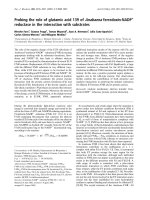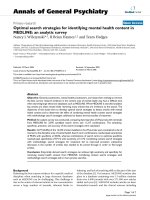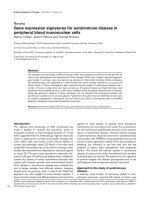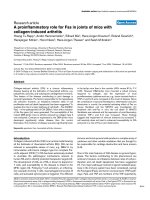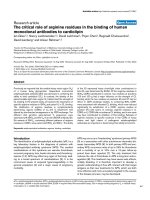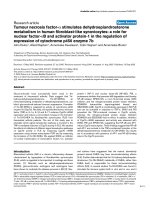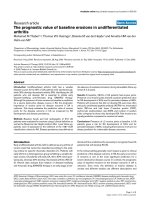Báo cáo y học: "An anti-inflammatory role for tranexamic acid in cardiac surgery" docx
Bạn đang xem bản rút gọn của tài liệu. Xem và tải ngay bản đầy đủ của tài liệu tại đây (35.8 KB, 2 trang )
Page 1 of 2
(page number not for citation purposes)
Available online />Abstract
Pro- and anti-inflammatory cytokines are elevated after cardiac
surgery. The control of the release of these major paracrine
proteins is becoming clearer and they have been shown to be
involved in the activation of the coagulation/fibrinolysis pathway,
among other cascades. The association of a predominance of pro-
inflammatory cytokines with morbidity in some patients, particularly
following cardiac surgery, is well described but still incompletely
understood. Clinical studies elucidating how clinicians may
influence this cytokine release directly will improve our knowledge
of the processes involved and could ultimately show benefit in
better outcomes for patients.
Cytokines are an intriguing group of soluble protein mediators
with a large number of described actions but short biological
range. These molecules are produced by a variety of cells,
including monocytes, macrophages, lymphocytes, and endo-
thelial cells. Such proteins include the pro-inflammatory
cytokines interleukin (IL)-6 and soluble tumour necrosis factor
receptor-1 (sTNFR-1), as measured by Jimenez and colleagues
[1] in their study. Cytokines have been shown to be important
in all biological processes [2], including inflammation in which
the major pro-inflammatory cytokines are considered to be
tumour necrosis factor (TNF), IL-1, and interferon-gamma in
addition to IL-6. They also have anti-inflammatory roles (IL-10,
transforming growth factor-beta, and IL-4). The control of this
balance between pro- and anti-inflammatory cytokines is vital
to the understanding of inflammation and the inflammatory
response in human disease processes.
Cytokines are normally subject to tight homeostatic control
and are produced in response to a variety of physiologic and
pathologic stimuli. Pro-inflammatory cytokines play a pivotal
role in initiating and amplifying the inflammatory process.
Furthermore, the plasma concentrations of certain cytokines,
such as IL-1 and IL-6, have been shown to be predictive of
outcome in specific subgroups of critically ill patients [3]. In
particular, TNF and IL-1 are elevated early following cardiac
surgery, with IL-6 and IL-8 peaking later [3,4]. This damaging
pro-inflammatory cytokine response is well documented in
patients who develop systemic inflammatory response
syndrome (SIRS) after cardiac surgery [4]. In this SIRS
patient group, IL-8 and IL-18 are higher in non-survivors
compared with survivors. The association of elevated levels of
pro-inflammatory cytokines with poor outcomes following
cardiac surgery has been demonstrated by many studies [5],
but a direct cause-and-effect relationship has not been
demonstrated.
The pro-inflammatory cytokine response to injury, including
cardiac surgery, is countered by the release of anti-
inflammatory cytokines. This anti-inflammatory response is not
limited to cytokine proteins alone (such as IL-10) but also
includes the release of soluble cytokine receptors (sTNFR-1
and -2) and cytokine receptor antagonists (IL-1 receptor
antagonist) [3]. This complex balance between pro- and anti-
inflammatory molecules is likely to influence outcome
following many pathophysiological insults, including cardiac
surgery.
While in some respects the coagulation cascade and the
inflammatory response are separate processes, they are
closely interconnected in acute disease. The activation of
coagulation is a key component of the acute inflammatory
response and vice versa, with the endothelium intricately
involved in both processes. Pro-inflammatory cytokines are
released at sites of local inflammation, leading to activation of
the endothelium and initiation of the coagulation cascade.
Cardiac surgery (in particular, cardiopulmonary bypass)
induces activation of the immune system by factors that
include (but are not limited to) contact activation of immuno-
logical cells, ischaemia-reperfusion injury, and endotoxaemia.
Commentary
An anti-inflammatory role for tranexamic acid in cardiac surgery?
Heidi J Robertshaw
1,2
1
St George’s Hospital, Blackshaw Road, London SW17 0QT, UK
2
Department of Anaesthesia, Alice Springs Hospital, Gap Road, Alice Springs, NT 0870, Australia
Corresponding author: Heidi J Robertshaw,
Published: 16 January 2008 Critical Care 2008, 12:105 (doi:10.1186/cc6210)
This article is online at />© 2008 BioMed Central Ltd
See related research by Jimenez et al., />IL = interleukin; SIRS = systemic inflammatory response syndrome; sTNFR-1 = soluble tumour necrosis factor-1; TNF = tumour necrosis factor.
Page 2 of 2
(page number not for citation purposes)
Critical Care Vol 12 No 1 Robertshaw
Once activated, the immune system amplifies its response
with activation of complement, cytokine production,
coagulation/fibrinolysis, endothelium, and the cellular immune
system. All of these processes, if unchecked, may lead to the
development of SIRS and a poorer outcome in this patient
group.
The use of tranexamic acid in the study by Jimenez and
colleagues [1] to attenuate inflammation reveals a glimpse of
how the fibrinolytic and pro-inflammatory responses are
interlinked. The interplay of other major pro- and anti-
inflammatory mediators is worthy of further study in this
patient group (in particular, TNF and IL-10) to further
elucidate the pathways involved and highlight the biological
targets involved in this attenuation of the inflammatory
response. Their study also, perhaps more importantly, yields a
practical, clinically applicable method of influencing these
often catastrophic cascades that, once initiated, can lead to
significant mortality and morbidity in subgroups of patients
following cardiac surgery.
In the last two decades, much scientific effort has led us
closer to a definition of the molecular basis of the
immunological response to biological insults and to the
development of specific ‘targeted therapies’ such as anti-TNF
treatment for rheumatoid arthritis. Each additional insight into
the control of inflammation and its interaction with other
biological responses, such as coagulation and fibrinolysis,
has the potential to lead to more effective interventions for
the clinician perioperatively and in the management of
critically ill patients.
Competing interests
The author declares that they have no competing interests.
References
1. Jimenez JJ, Iribarren JL, Lorente L, Rodriguez JM, Hernandez D,
Nassar I, Perez R, Brouard M, Milena A, Martinez R, Mora ML:
Tranexamic acid attenuates inflammatory response in car-
diopulmonary bypass surgery through blockade of fibrinoly-
sis: a case control study followed by a randomized
double-blind controlled trial. Crit Care 2007, 11:R117.
2. Feldmann M, Steinman L: Design of effective immunotherapy
for human autoimmunity. Nature 2005, 435:612-619.
3. Meduri GU, Headley S, Kohler G, Stentz F, Tolley E, Umberger R,
Leeper K: Persistent elevation of inflammatory cytokines pre-
dicts a poor outcome in ARDS. Chest 1995, 107:1062-1073.
4. Kawamura T, Wakausawa R, Okada K, Inada S: Elevation of
cytokines during open heart surgery with cardiopulmonary
bypass: participation of interleukin 8 and 6 in reperfusion
injury. Can J Anaesth 1993, 40:1016-1021.
5. Laffey JG, Boylan JF, Cheng DC: The systemic inflammatory
response to cardiac surgery: implications for the anesthesiol-
ogist. Anesthesiology 2002, 97:215-252.


